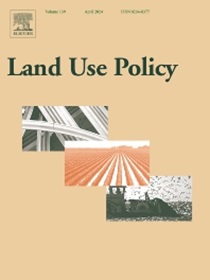基于多源异质数据的中国土地利用功能时空演化与耦合协调
IF 6
1区 社会学
Q1 ENVIRONMENTAL STUDIES
引用次数: 0
摘要
认识到国家尺度上土地利用功能的耦合协调对有效的土地利用管理具有重要的战略意义。本研究建立了基于多源异构数据的luf评价体系,并建立了理论分析框架。利用时间序列变化方法和耦合协调度(CCD)模型,分析了2001 - 2020年中国陆航空间空间格局的时空演化特征和耦合协调度。结果表明:近20年来,生产功能(PF)持续增加,而生活功能(LF)和生态功能(EF)呈现出先下降后恢复的趋势。中西部城市优质耕地面积扩大,但经济发展仍不充分,耕地利用率下降。在南方偏远农村地区,由于耕地撂荒,耕地利用率下降,而平原与山区之间的耕地利用率差距不断扩大。人口减少导致对教育和医疗服务的需求减少,从而导致死亡率下降。此外,中国LUFs的CCD显著增加,79.4% %的地区呈现正趋势,主要是指数和线性增长。负趋势主要表现为对数减弱。luf耦合协调的改善被推迟,而省际边界的恶化发生得更早。PF是驱动luf耦合协调性变化的主要因素。本研究不仅提供了识别luf的数据处理方法,而且为luf耦合协调的动力学提供了新的见解。本文章由计算机程序翻译,如有差异,请以英文原文为准。
Spatial-temporal evolution and coupling coordination of land use functions across China by fusing multiple-source heterogeneous data
Recognizing the coupling coordination of land use functions (LUFs) at the national scale is strategically important for effective land use management. This study developed a theoretical analytical framework and established an evaluation system for LUFs was using multiple-source heterogeneous data. Additionally, the spatial-temporal evolution and coupling coordination of LUFs across China from 2001 to 2020 were analyzed using time-series variation methods and coupling coordination degree (CCD) model. The findings revealed the production function (PF) consistently increased over the past 20 years, while the living function (LF) and ecological function (EF) showed a slight decline followed by a recovery. Cities in central and western China have expanded into high-quality farmland, yet economic development remains insufficient, and PF is declining. In remote southern rural areas, PF has fallen due to farmland abandonment, while the PF gap between plains and mountainous areas continuously widens. Population decline led to a reduction in demand for education and medical services, resulting in a decline in LF. Additionally, the CCD of LUFs in China significantly increased, with 79.4 % of areas showing positive trends, mainly exponential and linear growth. Negative trends primarily exhibited a logarithmic weakening pattern. Improvements in LUFs coupling coordination were delayed, while deterioration occurred earlier at interprovincial borders. PF was the leading factor driving changes in LUFs coupling coordination. This study not only provides data processing methods for identifying LUFs but also offers new insights into the dynamics of LUFs coupling coordination.
求助全文
通过发布文献求助,成功后即可免费获取论文全文。
去求助
来源期刊

Land Use Policy
ENVIRONMENTAL STUDIES-
CiteScore
13.70
自引率
8.50%
发文量
553
期刊介绍:
Land Use Policy is an international and interdisciplinary journal concerned with the social, economic, political, legal, physical and planning aspects of urban and rural land use.
Land Use Policy examines issues in geography, agriculture, forestry, irrigation, environmental conservation, housing, urban development and transport in both developed and developing countries through major refereed articles and shorter viewpoint pieces.
 求助内容:
求助内容: 应助结果提醒方式:
应助结果提醒方式:


